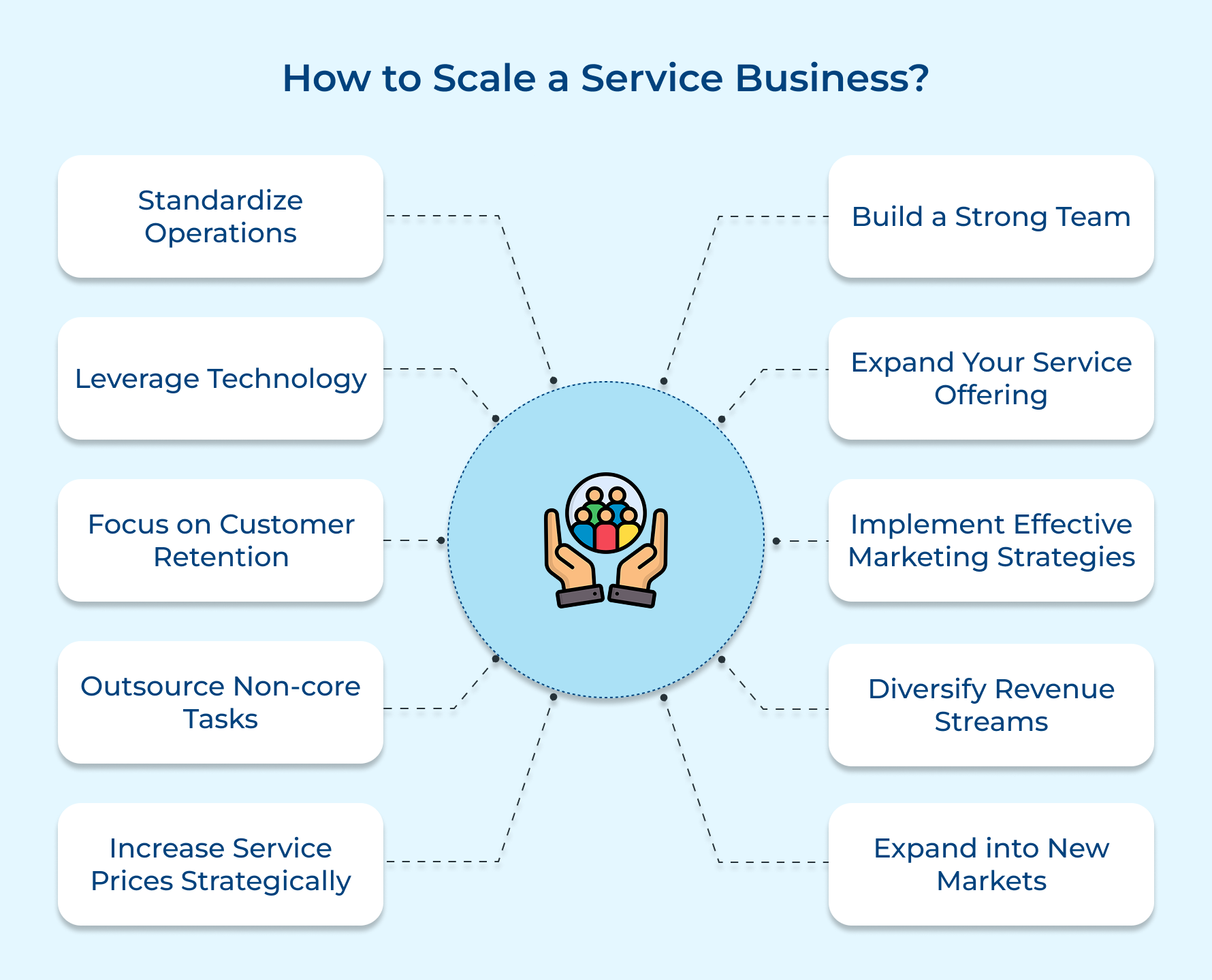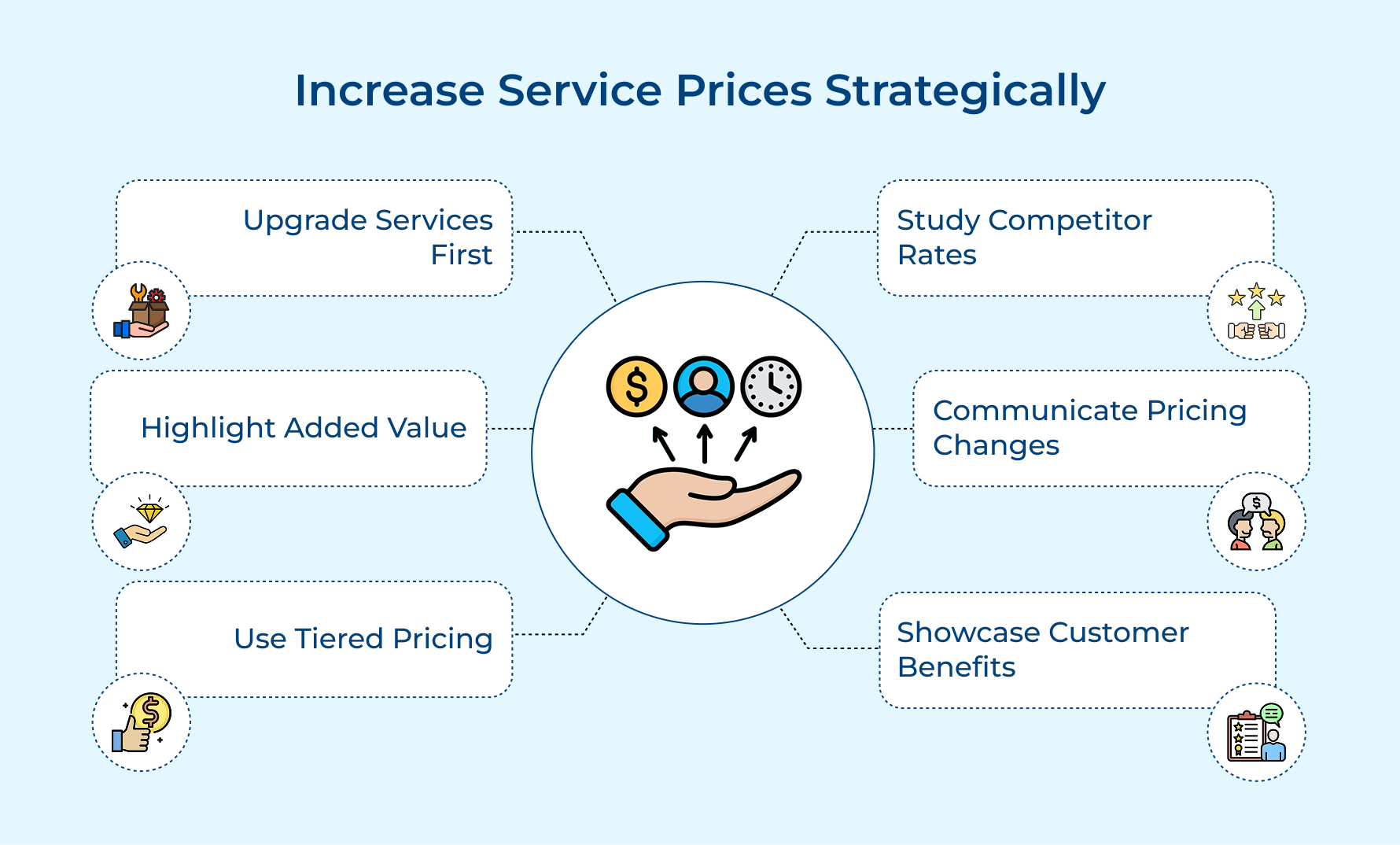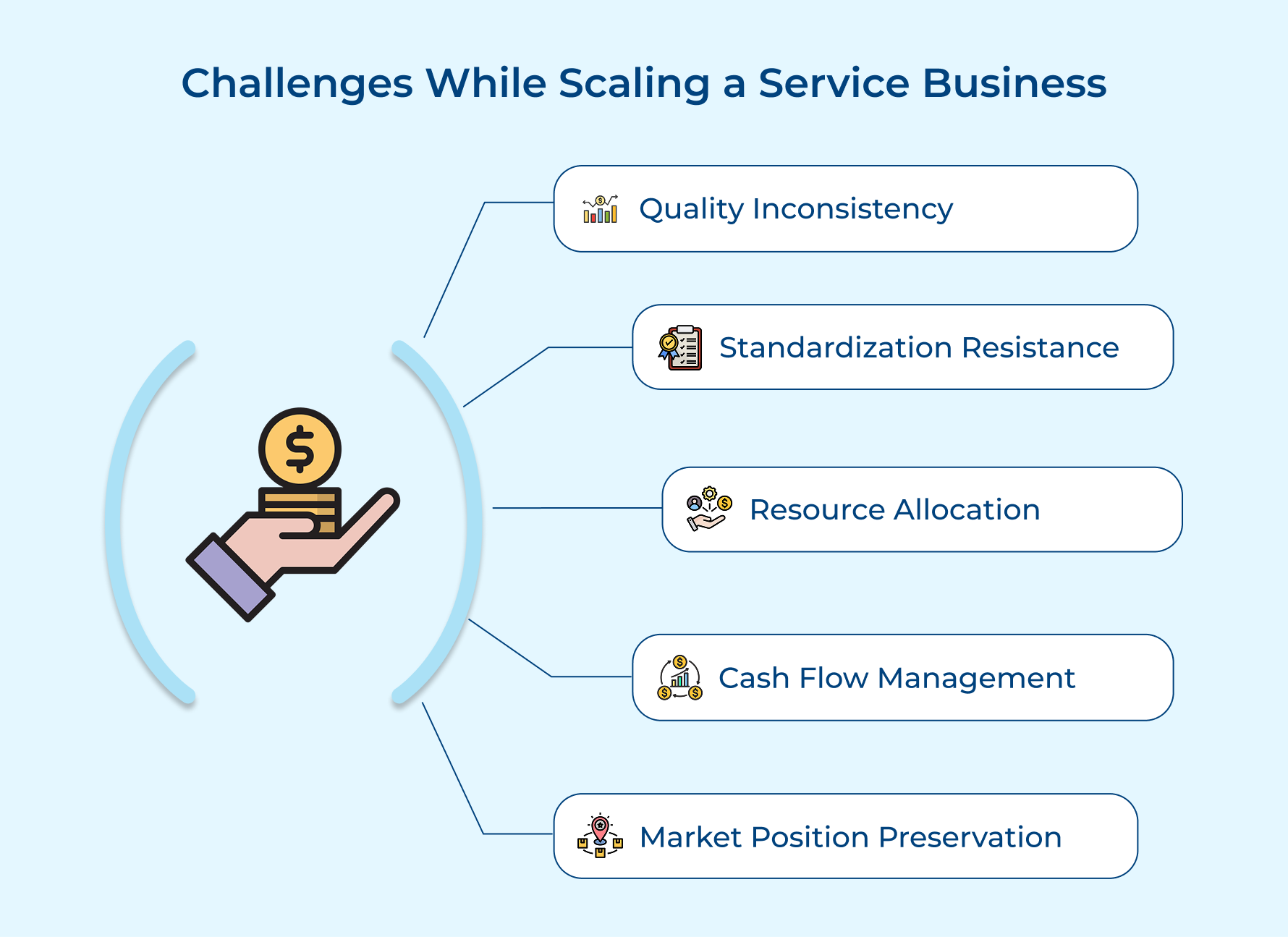10 Proven Strategies to Help Scale a Service Business

Key Highlights:
- To scale a service business successfully, customer retention, diversified revenue streams, and market expansion help drive sustainable growth.
- Standardizing operations while leveraging technology ensures efficiency, consistency, and scalability while maintaining high service quality.
- Strategic outsourcing and smart resource allocation free up time, reduce costs as well as enhance focus on core business growth opportunities.
Every entrepreneur dreams to scale a service business, but the journey is filled with hurdles. As demand increases, it’s easy to get caught in the chaos of managing growth, while still ensuring high service standards are maintained.
Scaling too quickly without a solid strategy can lead to overwhelmed teams, frustrated customers, and inefficient processes. With the right strategies, you can expand efficiently, increase your capacity, and keep your clients happy.
Let’s introduce you to 10 game-changing strategies to help you scale your service business smoothly while also maintaining sustainable growth.
Scaling Service Business: Definition
A scaling service business refers to the process of expanding a business’s capacity to serve more clients or generate higher revenue without a corresponding increase in costs or resources. Unlike simple growth, which might involve increasing resources proportionally, scaling ensures that the business can grow exponentially while maintaining or even improving profitability.
As a business scales, it becomes better positioned to capture larger market shares, expand its customer base, and increase profits. It also helps companies to better manage risk, increase market visibility, and gain a stronger position within their industry.
Key objectives:
- Maximizing efficiency: Streamlining internal processes to ensure smooth operations without sacrificing quality or customer experience.
- Expanding client base: Reaching a broader audience by targeting new markets, enhancing marketing efforts, or offering new services.
- Improving profitability: Boosting revenue while minimizing additional costs by leveraging existing resources more effectively.
- Sustaining quality: Maintaining or improving service quality even as the business scales to meet the growing demand.
How to Scale A Service Business: 10 Proven Strategies
Scaling a service business requires the right strategies to handle growth efficiently. These proven methods help expand operations while maintaining quality and profitability.
1. Standardize Operations
For business owners looking to scale, having well-defined processes is a game-changer. Standardization ensures consistency, improves efficiency, and helps teams deliver high-quality service every time. With structured workflows, you can make informed decisions and refine your growth strategies based on real insights.
Key Steps to Standardize Operations:
- Create clear workflows: Develop step-by-step processes for everything from client onboarding to service execution, ensuring uniform service delivery.
- Enhanced team training: A well-documented system makes it easier to onboard new employees and helps them follow best practices confidently.
- Improve decision-making: Standardized processes provide measurable data, helping you track performance and optimize your business growth strategies.
- Leverage automation tools: Automate repetitive tasks and integrate workflows to reduce errors as well as boost overall efficiency.
- Update SOPs regularly: Keep your standard operating procedures (SOPs) aligned with business changes and client feedback to maintain relevance.
2. Leverage Technology
For business owners looking to grow, adopting the right technology isn’t just an option—it’s a necessity. The right tools can streamline operations, enhance customer experiences, and help you make informed decisions for long-term success.
How Technology Fuels Business Growth,
1. Automate and Simplify Workflows
- Use CRM systems to manage customer interactions and track leads effortlessly.
- Automate repetitive tasks like follow-ups, invoicing, and appointment scheduling to free up time for strategic growth.
2. Improve Team Collaboration
- Project management tools help teams stay organized, track progress, and meet deadlines efficiently.
- Cloud-based platforms ensure seamless communication, even for remote teams.
3. Enhance Customer Experience
- Chatbots and AI-powered customer support tools provide instant responses as well as improve client satisfaction.
- Personalization tools help tailor services based on customer preferences, building stronger relationships.
4. Gain Data-Driven Insights
- Real-time analytics help you measure performance and refine growth strategies.
- Automated reporting tools offer valuable insights to optimize decision-making.
3. Focus on Customer Retention
Keeping your existing customers happy is one of the smartest business moves you can make. Why? Because loyal customers bring repeat business, referrals, and long-term stability—all without the high cost of constantly chasing new clients.
How to Keep Customers Engaged?
1. Make Them Feel Valued
- Imagine a client who’s been using your services for years. A simple “Thank You” message or an exclusive discount can make them feel appreciated and keep them coming back.
- Send personalized emails or follow-ups to show you care about their experience.
2. Reward Loyalty
- Offer a loyalty program—think discounts, priority service, or special perks for repeat customers.
- Even small rewards, like a free service upgrade after a few purchases, can make a big difference.
3. Ask for Feedback and Act on It
- Customers love being heard! Send out quick surveys or have a casual chat about what they’d like to see improved.
- Implement their suggestions where possible—it shows that you listen and care.
4. Outsource Non-core Tasks
Trying to do everything in-house can slow you down and eat into your profit margins. That’s where outsourcing comes in—it frees up your time so you can focus on growing your business while experts handle non-core tasks.
Outsourcing Helps Your Business Grow,
1. More Time for What Matters
- Imagine you run a home improvement service. Instead of spending hours on bookkeeping, you hire an accounting service. Now, you can focus on finding potential customers and expanding your reach.
2. Expert Help Without Full-Time Costs
- A digital marketing agency can run your ads and manage social media, bringing in leads without you hiring an in-house team.
- Outsourcing ensures specialized tasks are done right, boosting efficiency and service quality.
3. Scalability for Sustainable Growth
- If it’s payroll, customer service, or content creation, outsourcing keeps things running smoothly as your business grows.
- Regular check-ins with outsourced partners help maintain quality control and align efforts with your goals.
Smart outsourcing isn’t just about saving time—it’s about creating a sustainable growth strategy that lets you focus on what you do best.
5. Increase Service Prices Strategically
Increasing your service prices can feel risky, but when done strategically, it boosts profitability and keeps your business sustainable. The key is making sure your customers see the added value behind the price adjustment.
If you’ve upgraded your service, added new features, or improved customer support, a price increase makes sense. People are willing to pay more when they see real benefits. Instead of a sudden hike, consider a tiered pricing model—offering different packages to suit different budgets.
Before making changes, research competitor pricing and assess what makes your service stand out. When increasing rates, communicate openly with your customers. Let them know why the change is happening—whether it’s for better service, more features, or improved support.
6. Build a Strong Team
A skilled and motivated team is the backbone of any growing business. Hiring the right people who align with your vision and culture ensures smooth operations as well as high-quality service. Here’s how to build a strong team that supports business growth:
- Hire for Culture & Skills
Don’t just focus on qualifications—look for people who share your company’s values and can adapt to your work environment. - Set Clear Roles & Expectations
When everyone knows their responsibilities, there’s less confusion and more productivity. A well-structured team leads to better collaboration and efficiency. - Invest in Employee Growth
Training and skill development help your team stay ahead. Employees who see growth opportunities are more engaged as well as loyal. - Create a Positive Work Culture
Encourage teamwork, recognize good work, and create an environment where employees feel valued. A happy team is a high-performing team.
7. Expand Your Service Offering
Expanding your service offering means introducing new services or packages that complement your core offerings. This could include premium features, specialized services, or related products to meet broader customer needs.
Expanding services allows you to capture new customer segments and increase revenue per client. It also improves customer satisfaction by offering additional value, creating a more comprehensive service experience.
Assess market demand and customer feedback to identify areas for new services. Gradually roll out additional offerings through trial programs and offer these services at a discounted rate to loyal customers to build awareness.
8. Implement Effective Marketing Strategies
Marketing is about connecting with the right people at the right time. A mix of social media, content marketing, and paid ads can help you reach potential customers as well as boost sales.
Take this example: A home cleaning service wants to attract more local clients. Instead of relying solely on word-of-mouth, they post cleaning tips on Instagram, run Facebook ads targeting busy homeowners, and share customer testimonials online. Over time, their brand becomes more recognizable, and inquiries increase.
Different ways to implement strategies effectively:
- Create Valuable Content
Write blogs, social posts, or videos that answer common customer questions. If you run a fitness business, share quick home workout tips to engage your audience. - Use SEO to Drive Traffic
Optimize your website with the right keywords so people searching for your services can find you easily. - Run Paid Ads for Targeted Reach
Platforms like Facebook and Google let you target specific demographics—if it’s busy professionals, parents, or small business owners. - Leverage Customer Reviews & Testimonials
Positive feedback builds trust. Encourage happy clients to leave reviews on Google or share testimonials on social media.
9. Diversify Revenue Streams
Relying on just one source of income can be risky—market changes, seasonal dips, or unexpected slowdowns can impact your cash flow. That’s why diversifying your revenue streams is a smart move. By introducing complementary services, add-ons, or new pricing models, you can create financial stability and long-term growth.
Here’s how you can do it:
- Offer subscription-based services: Instead of one-time purchases, create a membership or recurring billing model.
- Introduce One-time Add-Ons: Upsell complementary products or services to existing customers.
- Sell digital products or courses: If you have expertise, package it into an eBook, course, or exclusive content.
- Explore strategic partnerships: Team up with businesses offering related services and create co-branded packages.
10. Expand into New Markets
If you want to scale your business, sticking to the same audience forever won’t cut it. Expanding into new locations, industries, or customer segments can open doors to fresh opportunities and revenue streams. Plus, it reduces reliance on a single market, making your business more resilient.
Ways to expand into new markets:
Research Before You Expand
- Understand the needs, preferences, and competition in the new market.
- Example: If you’re a marketing agency looking to target healthcare clients, study industry trends and pain points first.
Tailor Your Approach
- Adapt your services and messaging to fit the new audience.
- Example: A software company entering international markets may need to offer multilingual customer support.
Test the Waters First
- Run pilot programs or small-scale campaigns before making a full commitment.
- Example: A salon expanding to a new city can start with pop-up events before opening a full branch.
Build Local Partnerships
- Collaborate with businesses that already have a foothold in your target market.
- Example: A fitness coach expanding online can partner with local gyms for referrals.
Common Challenges While Scaling a Service Business
Scaling a service business is exciting, but it comes with its own set of challenges. From maintaining service quality to managing growing demands, here’s what to watch out for.
Quality Inconsistency
Maintaining consistent service quality becomes difficult as team size grows and more people handle client deliverables across different service areas.
Ways to overcome:
- Implement detailed quality control checklists and multi-level review systems for all deliverables.
- Create comprehensive training programs with regular skill assessments and certification processes.
- Build standardized templates and guidelines for all service components with clear quality benchmarks.
Standardization Resistance
Clients and team members resist standardized processes as well as deliverables, preferring customized approaches they’re familiar with.
Solve it by:
- Communicate the benefits of standardization to both clients and team members.
- Build flexibility into standardized processes while maintaining core efficiency benefits.
- Provide data-driven evidence of improved outcomes with standardized approaches.
Resource Allocation
Efficiently allocating human and financial resources becomes more complex with increased service volume along with variety.
Tips to follow:
- Implement resource management systems with clear visibility into capacity and utilization.
- Create standardized resource allocation models based on service type and complexity.
- Develop clear metrics for measuring resource efficiency and return on investment.
Cash Flow Management
Managing cash flow becomes complex with increased operating costs, longer payment cycles, and higher investments in growth initiatives.
How to resolve:
- Maintain 3-6 months of operating expenses in reserve before aggressive scaling.
- Implement strict accounts receivable processes and consider requiring upfront payments.
- Create detailed cash flow forecasts and monitoring systems with clear trigger points for action.
Market Position Preservation
Maintaining market positioning and competitive advantage becomes harder as the business scales and attracts more competition.
Solve it by:
- Continuously invest in differentiation through innovation and service improvement.
- Build a strong brand presence and thought leadership before aggressive scaling.
- Create and maintain detailed competitive analysis as well as market positioning strategies.
A Strategic Approach to Scaling Your Service Business
Scaling a service business presents both challenges and opportunities. As demand increases, adapting to new market conditions and optimizing internal processes become essential. It’s important to maintain a focus on the customer experience while expanding.
Focusing on the right strategies—like systematizing operations and increasing customer retention—allows you to grow your business without sacrificing the values that made it successful. Achieving a balance between growth and maintaining quality ensures your customers continue to receive exceptional service, building long-term success.
Limit time — not creativity
Everything you need for customer support, marketing & sales.
Neeti Singh is a passionate content writer at Kooper, where he transforms complex concepts into clear, engaging and actionable content. With a keen eye for detail and a love for technology, Tushar Joshi crafts blog posts, guides and articles that help readers navigate the fast-evolving world of software solutions.


